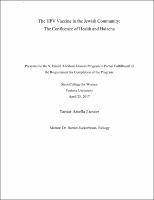Please use this identifier to cite or link to this item:
https://hdl.handle.net/20.500.12202/4239| Title: | The HPV Vaccine in the Jewish Community: The Confluence of Health and Halacha |
| Authors: | Lunzer, Tamar Ariella |
| Keywords: | Papillomaviruses. Cancer --Immunological aspects. Cancer --Prevention. Vaccination --Religious aspects. Health --Religious aspects --Judaism. |
| Issue Date: | Apr-2017 |
| Publisher: | Stern College for Women |
| Abstract: | Human Papilloma Virus (HPV) is reported to be responsible for nearly 90% of cervical cancers, 90% of anal cancers and is a significant component of the etiology of vaginal, vulvar and oral cancers as well. Added to the morbidity and mortality secondary to these cancers, the virus causes precancerous cervical lesions and genital warts which in themselves cause pain, discomfort and require medical care. However, unlike with most other cancers, there is an approved vaccination against HPV, aimed at preventing the development of HPV related conditions and cancers. When the vaccine was first approved in 2006, the Center for Disease Control (CDC) published guidelines recommending that all girls receive the HPV vaccine, ideally starting at age 13-15. However, since then, in spite of multiple public service campaigns, the uptake remains low with rates of vaccination among female adolescents remaining at only 42% as of 2015. As part of Healthy People 2020 initiative, the CDC aims to have an 80% of all adolescents between the ages of 13-15 years old vaccinated by the year 2020. The barriers to increased vaccination acceptance are multidetermined and include socio-cultural factors among parents, adolescents and physicians. Religious beliefs are hypothesized to be one such element. This paper will outline the factors that impede vaccine adoption and provide an analysis of these factors with a focus on the Jewish perspective particularly in the American Orthodox community, along with potential suggestions for improved vaccination penetration. This paper will focus only on female vaccination, as although the CDC now recommends that males be vaccinated as well, much of the research is based on parents vaccinating specifically their daughters as a protection against cervical cancer. The form of the vaccine referenced in most of the research can be assumed to be either the quadrivalent or bivalent form, as the nonavalent form is still fairly new. Given that research comparing the three versions of the vaccine has found equivalent, if not higher efficacy, between the bivalent/quadrivalent and nonavalent forms, there is no reason to differentiate between findings, especially as it relates to perspectives and health beliefs, from one version of the vaccine to another form. |
| Description: | The file is restricted for YU community access only. |
| URI: | https://hdl.handle.net/20.500.12202/4239 https://ezproxy.yu.edu/login?url=https://repository.yu.edu/handle/20.500.12202/4239 |
| Appears in Collections: | S. Daniel Abraham Honors Student Theses |
Files in This Item:
| File | Description | Size | Format | |
|---|---|---|---|---|
| Tamar-Ariella-Lunzer.pdf | 218.05 kB | Adobe PDF |  View/Open |
This item is licensed under a Creative Commons License

